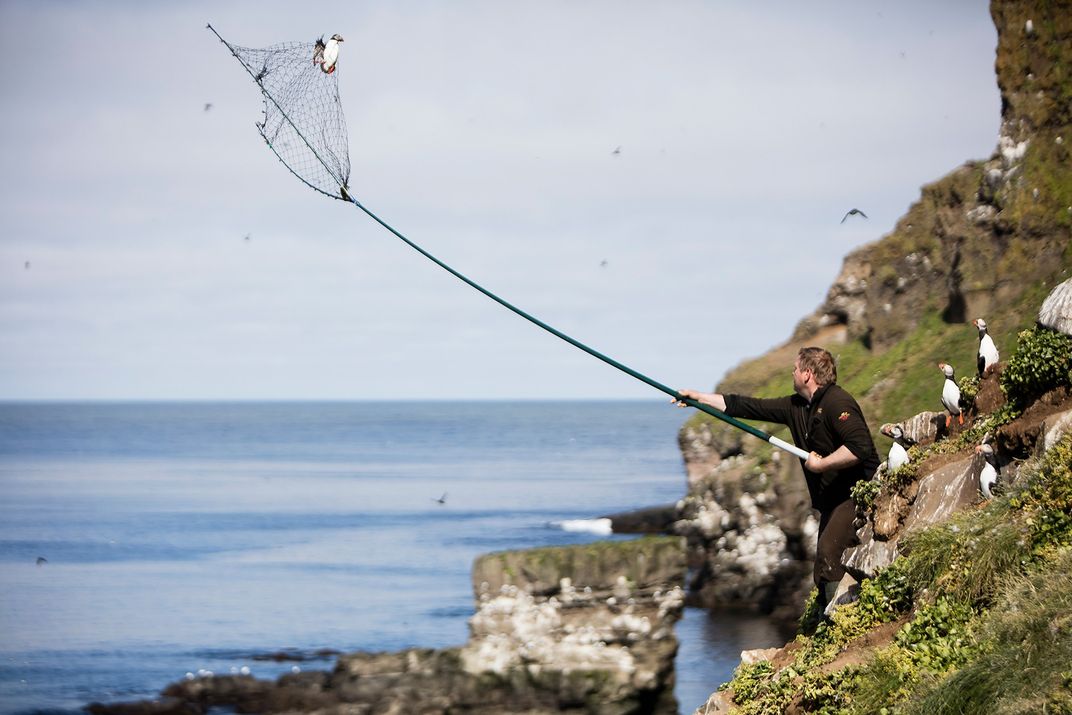Disappearing Puffins Bring an Icelandic Hunting Tradition Under Scrutiny
Historically, hunting seabirds has been a distinctive feature of Nordic coastal culture. Should it still be?
/https://tf-cmsv2-smithsonianmag-media.s3.amazonaws.com/filer/c2/2e/c22ea05f-327e-4bda-b4fd-44e42b427bcb/header-last-puffin-hunt.jpg)
This article is from Hakai Magazine, an online publication about science and society in coastal ecosystems. Read more stories like this at hakaimagazine.com.
A wheel of wings spins around Grímsey Island, Iceland’s northernmost outpost. This eyebrow of land 40 kilometers above the mainland crosses the Arctic Circle. It’s home to some 70 residents, with one street, a tiny grocery store, a slash of airstrip roughly a third the length of the island, and a signpost pointing to the 66°33’ N parallel, across which tourists drive golf balls into the Arctic. In the brief high North summer, the island belongs to seabirds.
Thousands and thousands of kittiwakes, puffins, Arctic terns and more transform Grímsey into a bird nursery bustling under the constant light of the midnight Sun. Birds nestle in sea cliffs, brood in wildflower-filled meadows, patrol rocky burrows and raft on the cold North Atlantic waters. And they cluster on the tarmac, erupting in clouds when planes ferrying day-trippers circle in.
It’s balmy for the Arctic on this July day, and Árni Hilmarsson relaxes outside in jeans and a wool sweater. Hilmarsson, a fisherman from the other end of the country, is on a seabird quest. He and a half-dozen other men have traveled to Iceland’s far north from the Westman Island of Heimæy (population around 4,500), about 10 kilometers off Iceland’s south coast. They’ve made two boat crossings and have driven more than 500 kilometers—a long day’s journey—in pursuit of black-and-white birds with enormous red-and-yellow-striped bills: Atlantic puffins. They’re here for the age-old Nordic tradition they call lundaveiðar [LOON-da-veyth-ar]: the summer puffin hunt.
“Since I was a little boy, I was always catching puffins,” says Hilmarsson, who’s in his 50s and grew up hunting seabirds in the Westman Islands. “Each year, I would catch 5,000, 6,000. I was raised up on bird meat.”
We’re sitting near the Arctic Circle signpost outside the two-story yellow house that serves as Grímsey Island’s hotel. Hilmarsson unwinds with a smoke after hours crouched on a wet, tick-loaded hillside, sweeping birds from the sky with a long-handled net. His party of fathers and sons, neighbors and friends, has come to catch puffins with a triangular net, or háfur [HOW-verr]; the older ones teaching the youngsters, like their elders taught them. And the group—all members of the same Westman Islands hunting club, a hub of island social life—has a mission: to fetch birds for the puffin-hungry folks at home.
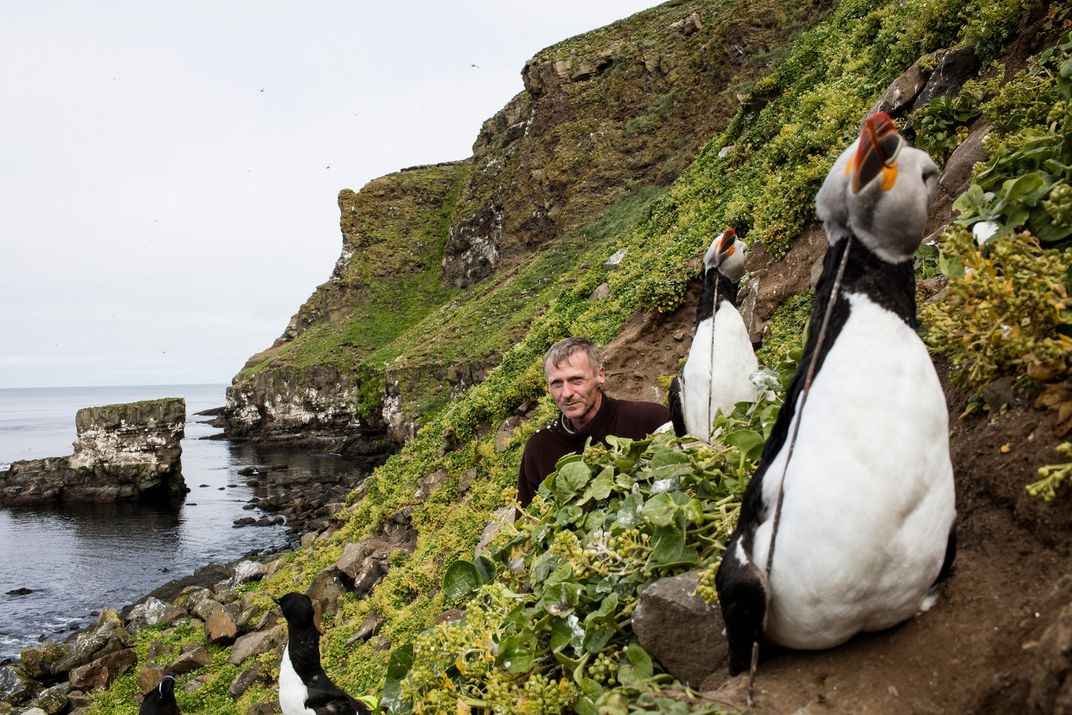
For centuries, seabirds have been crucial to the coastal peoples of the North Atlantic. Viking Age explorers followed ocean foragers such as guillemots and gannets to new shores. Vast colonies of kittiwakes and puffins sustained the settlements they established on the harsh seaboards of Iceland, eastern Greenland and the Faroe Islands. For the settlers, seabird hunting and egg gathering meant the difference between life and starvation. For their descendants, the tradition lives on as the heart of community identity.
The seabird harvest is a test of nerve: Men dangle on ropes dozens of meters above the sea, plucking eggs from cliff-side nests. It’s a test of skills: Gauging flight paths and timing the háfur swing just right to snag a bird mid-air. For some, it’s a small source of income. For most, it’s the essence of a cherished cuisine. And above all, it’s a tie between generations, a link to their maritime past, a bit of a taste of the sea.
But North Atlantic seabirds and the way of life surrounding them are now disappearing. Seabird populations have plunged up to 60 percent in parts of the region over the past decade due to climate change and other human activity. Breeding failures in the once-prolific nesting colonies are widespread. Five species native to Iceland, including the iconic Atlantic puffin, are now on the BirdLife International/International Union for Conservation of Nature’s Red List as near-threatened or vulnerable.
Hilmarsson tells me his home in the Westmans used to be prime puffin territory. The volcanic archipelago hosts a mega colony that’s the largest Atlantic puffin breeding site in the world. But the ecosystem has gone awry. Warming coastal waters have decimated chick production for more than a decade. The picture is similar around most of Iceland and extends south to the Faroe Islands and throughout the northeast Atlantic.
“We cannot catch puffins on Westman Islands,” Hilmarsson says. His sharp, weathered features crease up. After the long run of breeding catastrophes, Westman authorities limited the local hunting season to three days in 2016, down from five the year before. Only a couple hundred puffins can now be taken there.
Outsiders may bristle at the thought of eating this endearing—and often anthropomorphized—bird with the clownish honker. But it’s almost a ritual for the 332,000-odd residents of Iceland. Puffin cuisine stars in family gatherings, community events, holidays, and feasts that fortify north folk as winter approaches.
“We have to eat puffin once or twice a year,” Hilmarsson says. He squints at the snow-capped peaks glinting on the mainland. “Especially on Thjóðhátíð.”
He’s talking about a huge festival held in the Westman Islands every summer. The event began in 1874, when bad weather prevented Westman Islanders from traveling to the mainland for the nation’s 1,000th anniversary celebration, so they decided to hold their own. The party is legendary—a multi-day bacchanalia drawing revelers from all over Iceland and beyond. The Thjóðhátíð [THYOTH-how-teeth] is only a few weeks away. And Hilmarsson’s club is supposed to provide the birds.
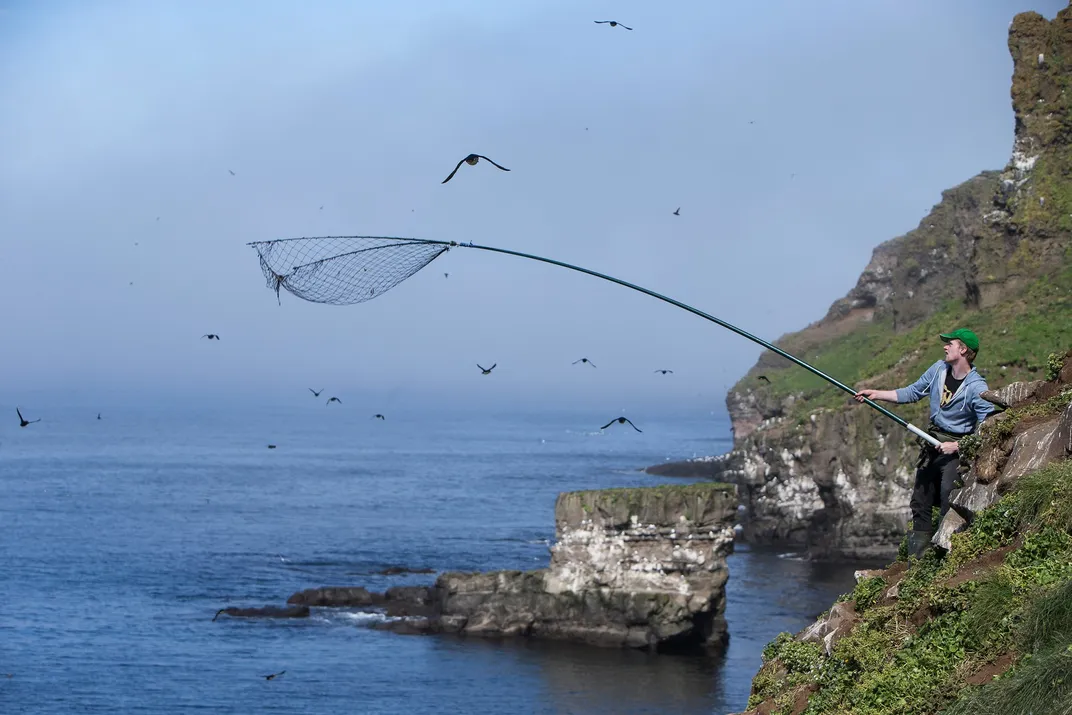
Millennium-Old Culture on the Edge
“It’s difficult for Westerners to grasp the importance of harvesting seabirds to the Nordic people,” says Danish biologist Carsten Egevang. “There’s a strong sense of pride in doing things like your father. I’ve seen it in the Faroe Islands, Greenland, all the Nordics.”
Egevang, a researcher for the Greenland Institute of Natural Resources in Nuuk, Greenland, is traveling around the North Atlantic studying Old Norse traditions that are now declining along with the seabirds. The project, planned to culminate in a book, combines science, anthropology, and art. A keen photographer, Egevang has gone out in boats with seabird hunters in Greenland, and hung from cliffs with Faroe Island egg harvesters to capture images of a fading culture. He’s now on Grímsey Island with Icelandic ornithologist Aevar Petersen to record what may be one of the last vestiges of lundaveiðar.
We’re walking on a rutted dirt road along Grímsey’s west coast, on our way to watch the Westman Island hunters in action. Egevang totes a gear-filled backpack nearly twice his girth. It’s early morning, but the midsummer Sun hovers near the same high piece of sky as at dinnertime last night. Birds soar and swoop around us. Plunging snipes whirr like badminton shuttlecocks. Arctic terns give a bandsaw screech as they dive for our heads. And rows upon rows of puffins line the clifftops, like tuxedo-clad sentries at their posts.
Egevang has spent the past two decades monitoring Greenland’s seabirds and watching their numbers drop. Over time, being around hunters and their communities, he became aware of the societal consequences as well.
“There are so many cultural traditions bound to harvesting seabirds,” Egevang says. “In the old days, it was a matter of survival. And of course it’s not like that anymore, but the tradition still carries on.”
The extensive use of seabirds has long been a distinctive feature of Nordic coastal culture. Seabirds are mentioned in Norse sagas as early as the 9th century, and their bones have been found in the middens of Viking settlements. Landowners’ hunting rights, along with regulations restricting hunting near colonies where eggs are collected, are laid out in a 13th-century Icelandic law book. A land register makes note of good puffin cliffs in the early 1700s. Hunting and egg gathering prowess bestowed personal fame, community pride. It’s a millennium-long thread between generations.
“People really care for these traditions,” Egevang says. “They will literally set their life at risk to get, say, fulmar eggs, when they could easily go to the store and buy chicken eggs. … They are doing this because they like it, because they feel that it’s part of their heritage.”
We reach the spot where the Westman Islanders are hunting. Streams of bird shit streak the hillside like vats of whitewash overturned. A brisk sea breeze broadcasts the acrid, fish-tinged funk. Clutching a rope, we ride the guano slip-and-slide down the long, steep slope to the hunters’ blinds. A galaxy of puffins swirls around us, circling between ocean and land.
Tucked behind rocks, the hunters wait for an off-course straggler or a burst of wind to push a bird within reach of the háfur hidden at their sides. Suddenly, a net arcs across the sky, then swoops back to ground with an angry puffin tangled in its web.
“It reminds me of back home when I was a kid,” says Ragnar Jónsson, an orthopedic surgeon who grew up in the Westman Islands and has come to Grímsey for a taste of the past. As a youngster, he tells me, he spent summers climbing all over the bird cliffs with a pole and net. He speaks of the nature and the bird life and the freedom. “There were no restrictions,” he says wistfully.
Like many Icelanders, Jónsson seems reticent about discussing his people’s seabird harvest traditions, aware that outsiders may find them controversial. “A lot of people think it’s disgusting that we eat seabirds,” he says, “but it’s part of our culture.”
But the environment is changing, Jónsson acknowledges. The rapacious Viking spirit must find a way to adapt. For him, seabird hunting has become a way to relax and enjoy the outdoors. And while his companions scoop up puffin after puffin, he sits with just one stashed in a hollow behind him.
“It’s beautiful here,” Jónsson says, gazing at the flocks drifting over sparkling water. “I like to sit and watch. It’s not just about catching as many as you can. Been there, done that.”
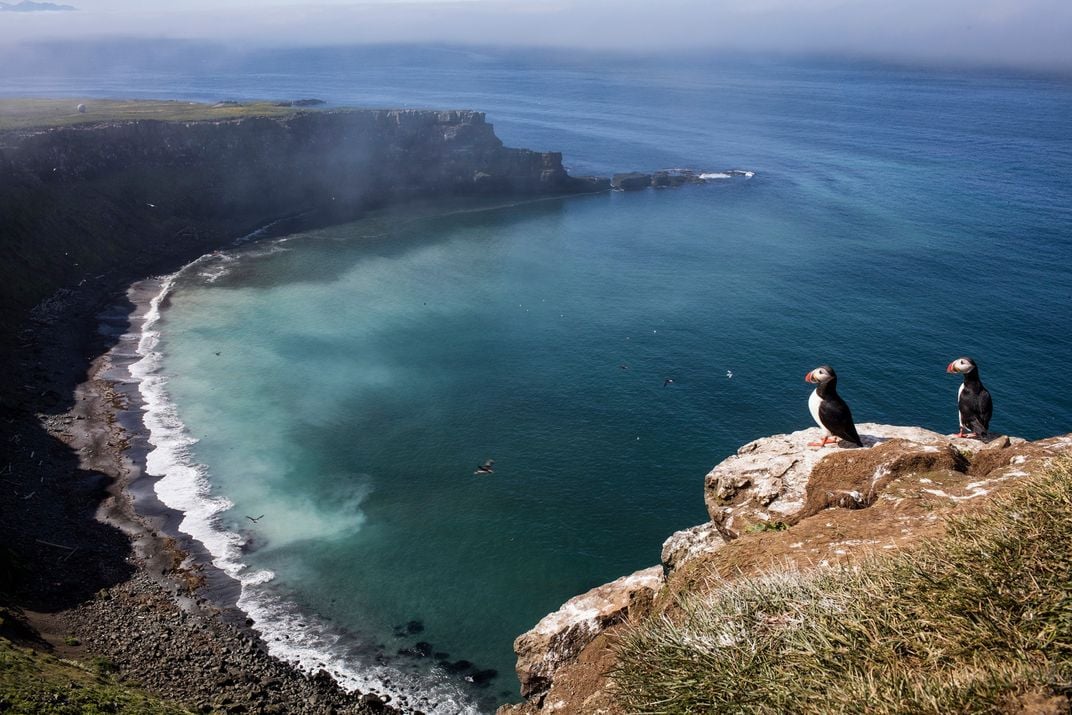
In Our Blood
Culture. Heritage. Tradition. I hear those words a lot as I stroll around Grímsey Island, passing small clusters of hunters every kilometer or so.
“This is in our blood,” says Hilmar Valur Jensson, a Heimæy tour guide hunting with the Westman Islanders on the steep cliffs of Grímsey’s northwest coast.
“Today we [hunt] mainly for the heritage,” says Ingólfur Bjarni Svafarsson, a teenaged Grímsey native, whom I encounter on the road to the lighthouse at the island’s southern tip. Svafarsson has hunted seabirds on Grímsey as long as he can remember—going out with his father before he was big enough to hold the net. He hopes to teach his own kids someday.
What about women, I ask Guðrún Inga Hannesdóttir, who is having a picnic with her young son, Hannes, on the high path over the island’s grassy spine. Do Icelandic women see hunting and egging as just a macho thing? Even kind of old school?
“I think it is cool that they still do that. … It’s not old school at all,” says Hannesdóttir, a teacher at the island’s seven-student primary school. Even though the actual harvest is mainly a male activity, she says, everyone enjoys the outcome.
Life on Grímsey is intertwined with seabirds. The small rocky island has been inhabited since the first Norse settlers arrived in the early 900s. The abundance of birds was one of the main draws, and eggs were a key source of income before fishing became king. The island’s sole restaurant is named Krían—Icelandic for the Arctic tern, a striking white creature so abundant and aggressive that people wave poles over their heads to fend off its attacks when they walk outside. Murre and razorbill eggs from the island’s cliffs sit next to cookies in the cafe’s bakery case.
But it’s puffins that rule. In summer, háfurs are as ubiquitous here as surfboards in Hawai‘i—sticking out of car windows, leaning against bicycles, propped against practically every house. Young and old share this passion, from former sheriff Bjarni Magnusson, who, at 86, bagged around 40 puffins this hunting season, to 14-year-old twins Ásbjörn and Thórólfur Guðlaugsson, who together caught 86 puffins in one day. It was their first time.
“Our brother taught us,” says Ásbjörn, cleaning his catch in a shed by the harbor. “It’s fun, and we have money,” Thórólfur adds. They plan to sell part of their haul to people craving a taste of puffin in Reykjavik and the Westman Islands.
The háfur looks something like a car-length lacrosse stick and is a fairly recent adaptation. Imported from the Faroe Islands, it arrived in Iceland around 140 years ago, supplanting more strenuous—and more destructive—old methods, such as pulling chicks from burrows with hooked sticks. The long-handled nets catch mostly juvenile birds that are too young to breed—flying around like bored teenagers with no responsibilities and little else to do. By centering on the nonbreeders, hunters maintain they are not harming the overall population. As a further safeguard, they avoid capturing birds with food in their bills: a sign of parents rearing chicks.
These days, however, few young puffins are even around to catch outside of Grímsey Island and other colonies in the north. So far, these places continue to produce offspring, but the marine ecosystem is changing fast, especially in the Arctic.
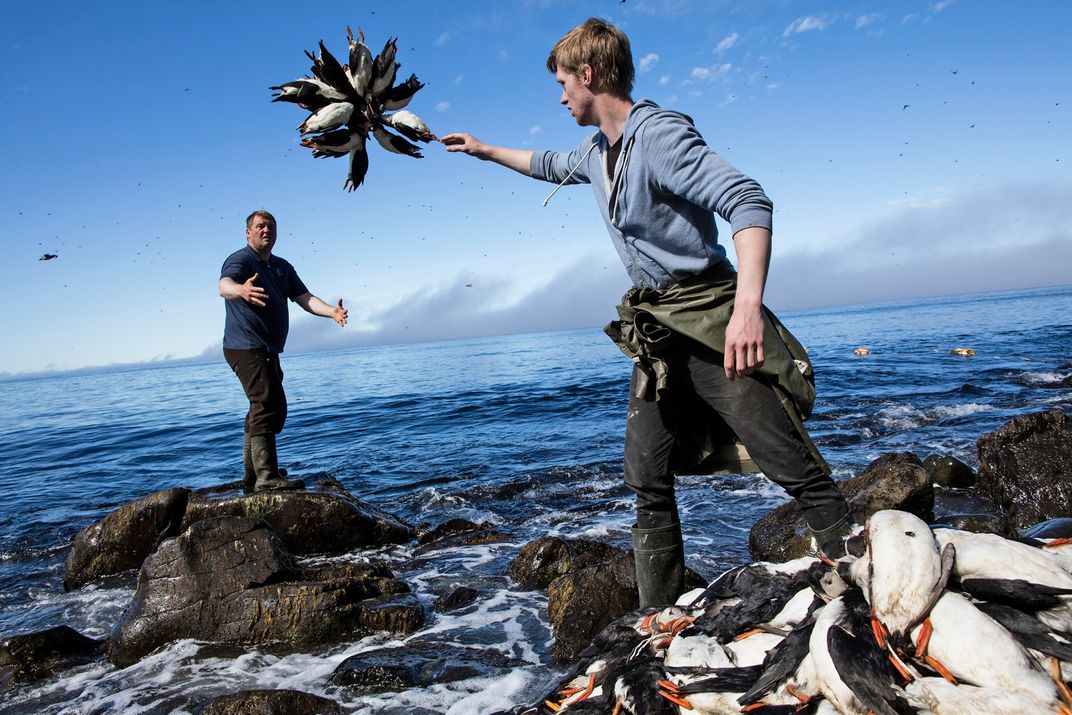
Sobering Statistics
While Egevang photographs the hunters, Petersen counts the birds. Treading carefully across slippery rock beaches, stepping gingerly over burrows potholing the hillsides, he scans the cliffs for kittiwake and fulmar nests.
Red-faced from the driving wind, Petersen is a real Icelander, outside in shirtsleeves despite the cold. But the graduate of universities in England and Scotland speaks English with a slight Scottish lilt. The former researcher for the Icelandic Institute of Natural History has been surveying Iceland’s seabird colonies for more than 40 years. Now retired, he continues to travel around the country keeping track of its avian populations.
“The kittiwakes are doing terribly,” Petersen says, as we encounter yet another dead white bird with wing tips that look like they were dipped in black ink. When he last surveyed this part of the island, in 1994, he counted more than 3,300 active kittiwake nests. This year, there are only about a quarter as many. He’s seen the same trend at his study sites in western Iceland, where he’s also found sharp drops in Arctic terns, puffins, and other seabirds. Similar trends are being noted in colonies from Scotland to Norway, and beyond.
The statistics are sobering. The North Atlantic basin is a crucial habitat for many of the world’s marine birds. More than two dozen species breed in the region’s cold, food-rich waters. Iceland alone hosts some 22 species, including a substantial portion of the northern hemisphere’s Atlantic puffins, common murres, northern fulmars, razorbills, black-legged kittiwakes, and Arctic terns. All of these species are now in trouble.
A host of factors is behind the North Atlantic’s seabird declines, including introduced predators, large-scale fisheries vacuuming up their prey, by-catch, excessive harvesting, and more, with differences depending on species and location. One force, however, is common throughout the region: profound ocean disturbances driven by climate change.
“Something seems to be happening to the food supply of seabirds over a large area of the northeast Atlantic,” says Morten Frederiksen, a seabird ecologist with Denmark’s Aarhus University, “and climate change is the most obvious explanation.”
The waters of the North Atlantic have been warming at an alarming rate, particularly in the coastal regions where breeding seabirds forage. Along south and west Iceland, ocean temperatures rose 1 to 2 °C since 1996.
Warmer waters are disrupting the ocean’s food web and driving away the fish that seabirds such as puffins need to feed their young. Puffins in the Westman Islands and many other colonies in the region rely on a pencil-shaped fish known as sand lance or sand eel. As these fish vanish, puffin parents have a hard time getting enough food for their young. According to biologist Erpur Snaer Hansen, of the relatively few chicks born in the Westman Islands last summer, nearly all starved to death. The same thing happened the three previous summers. In fact, this crucial colony has failed to produce a new generation of puffins for more than a decade.
Hansen, based at the South Iceland Nature Research Centre in the Westman Islands, is Iceland’s puffin specialist. Every summer, he circumnavigates the nation twice on a breakneck tour he calls the “puffin rally”—each time traveling more than 2,500 kilometers by car, boat, and airplane to visit 12 colonies in two weeks. On the first trip, early in the season, he surveys occupied burrows and snakes an infrared camera inside to look for eggs. On the second, he uses the burrow camera to count chicks.
His latest counts do reveal good news. North and west Iceland had their best seasons in several years, he tells me in an email. Even so, over the long term, Hansen’s studies show none of Iceland’s puffin colonies are really doing well. Populations in the south and west have plunged, and the eastern colonies are shrinking. Even here in the north, where puffins appear to be flourishing, they’re basically just treading water.
Should puffin hunting continue? Hansen is well aware of the cultural charge surrounding this question and the likely fallout from hunters riled by his response. I can almost hear a resigned sigh as he writes, “My professional advice is absolutely no hunting until after the population has recovered and produced chicks for several years.”
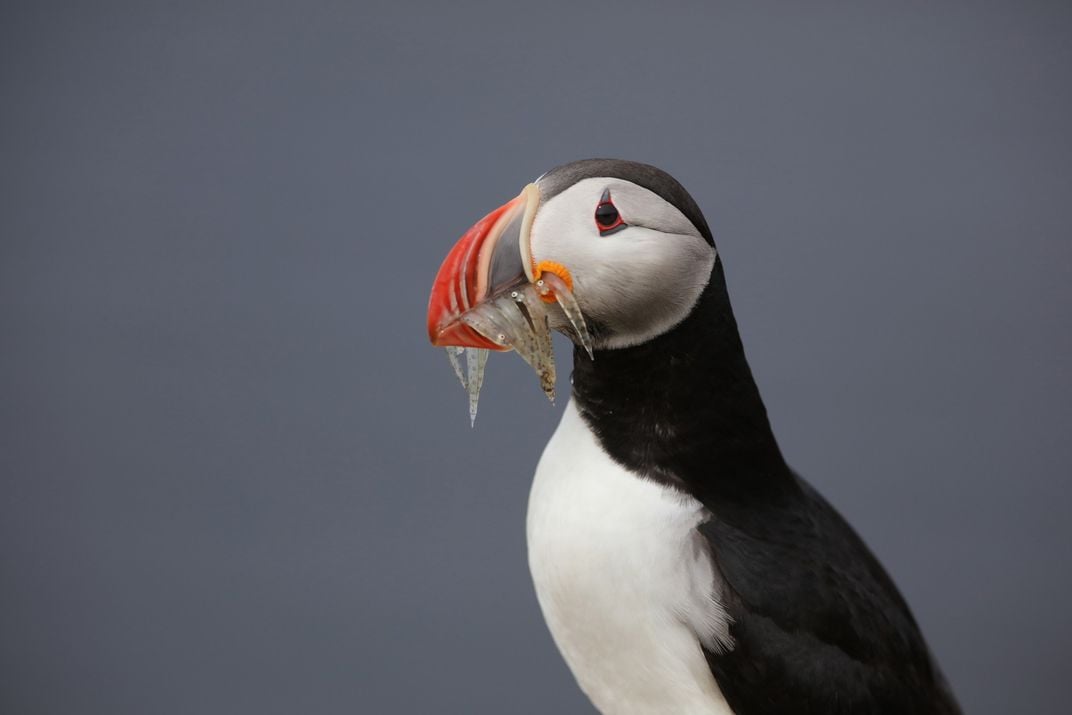
Nowhere to Go
The wind has risen to a near gale when Petersen, Egevang, and I meet at the Krían for an afternoon beer. Raising glasses embossed with long-bearded brutes in horned helmets—headgear the real Vikings probably never actually wore—we dive into a discussion of the changing North Atlantic ecosystem.
“In the last 10 years or so, I’ve heard so many stories about species appearing where they didn’t used to,” says Egevang. In Greenland, “all of a sudden tuna have started to appear.”
“A lot of new species are now coming into our waters too,” says Petersen, speaking of Iceland. “Fish, invertebrates, whales. Local species are moving north.”
As the North Atlantic region heats up, some residents—most notably humans—have the means to adapt. Others, such as cod, whose breeding output rises as waters warm, could find new opportunities in the emergent conditions. But for stalwart native birds—such as the Arctic tern, which endures a grueling pole-to-pole migration twice a year, and the plucky puffin, which dives up to 60 meters deep in frigid waters in pursuit of prey—the potential gains are far outweighed by the losses.
“It’s not the temperature increase that’s harming the birds,” Petersen points out. “It’s all the things that could be coming along with that.” Things like disease, shrinking food supplies, invasive species, increased storms, and off-kilter seasons.
The birds can try to move farther north. But the lack of suitable nesting sites at higher latitudes and the extra kilometers that would be added to their annual migrations severely constrain their options. They’re already near their northern habitat limit.
Says Petersen: “There’s nowhere for them to go.”
Faced with declining seabird populations, a report by the Nordic Council of Ministers states, this coastal culture’s distinctive traditions are fast becoming history. Many North Atlantic nations, including Norway, Sweden, and Scotland, have already halted most seabird hunting. And though it’s been curtailed in Iceland, Greenland, and the Faroe Islands, the report concludes, current harvest levels may still be unsustainable.
A Very Native Dinner
The night before they leave Grímsey, the Westman Islanders cook a puffin dinner for Petersen, Egevang, and me. A huge pot bubbles on the stove at the yellow guest house for hours, filling the air with the cloying redolence of burning tires.
Finally a platter piled with what looks like chocolate-colored Cornish hens is served, along with a lecture on how to eat them. You must crack the chest, I’m told. Suck the flesh off the wings and neck. Make sure to eat the insides too. Nearly every bit of the puffin is eaten.
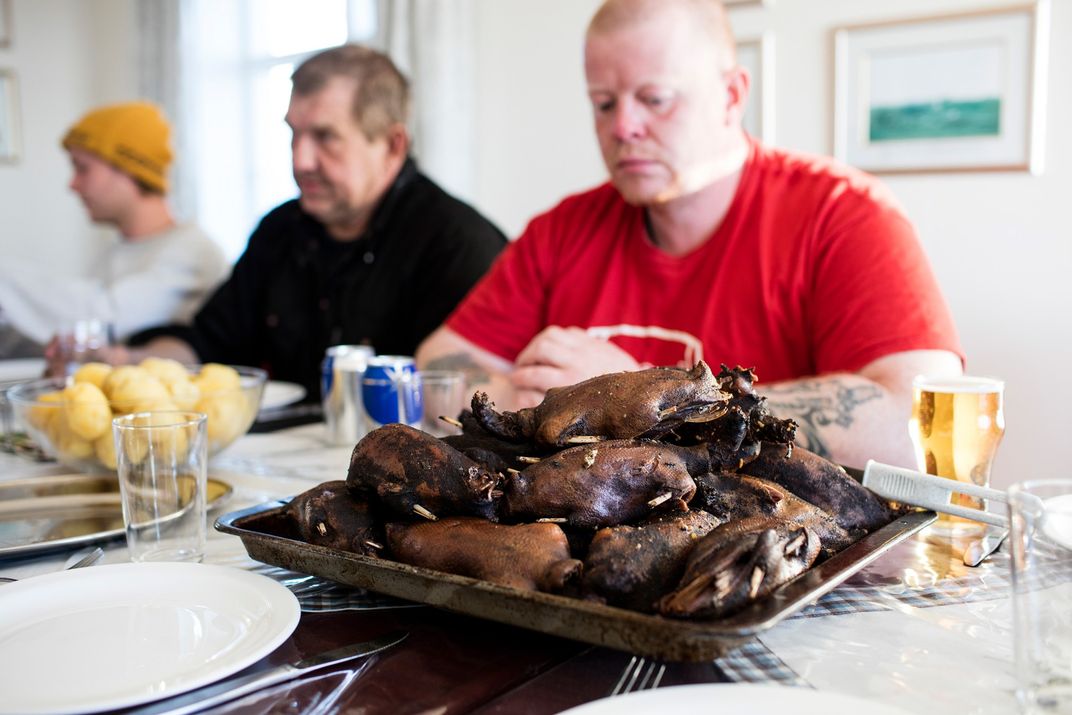
This is a very native dinner, the men announce. They’ve worked hard to prepare this meal and they’re clearly proud of their effort. Tonight’s recipe is a time-honored dish called “puffin in his tuxedo,” a traditional Christmas dinner in the olden days.
I take a bite. The scorched-rubber bouquet carries through in the taste, with a lingering fish-oil finish. I try to eat it all, but I can’t. Despite their small appearance, these birds have an amazing amount of meat. And for me, a little taste is plenty.
I give up, and pass mine to Andri Fannar Valgeirsson, the young man sitting next to me. He eats it with gusto, recalling memories of holidays past. The taste of puffin, he says, “makes me feel like a little boy again.”
Valgeirsson is a Westman Islands fisherman like his father. They’ve both come here to hunt. It’s his first time, and he shows me the cuts on his hands where the puffins scratched and bit him as he removed them from the net. Still, he enjoyed it.
“I didn’t know it was so much fun,” he says, rubbing his sore hands. “I want to do it again.” The best part was getting to learn from his dad—something he can no longer do in his own part of the country.
“It’s kind of sad,” Valgeirsson says. “I really want to do what my father does. Hunting, it’s connected us.”
Tomorrow Valgeirsson, Hilmarsson, and the others will hunt again. They’ll catch their quota of around 120 birds per person, and start on the long trek home. The Thjóðhátíð celebration will once more be able to offer a taste of the sea.
But someday, perhaps soon, the storied Norse seabird legacy will likely come to an end, another casualty of the changing climate and changing times.
Or maybe a new generation of these hardy wayfarers will write a new chapter for the old Viking saga.
Young Hjalti Trostan Arnheidarson, the innkeeper’s 11-year-old son, has been listening to the conversation. He says he wants to carry on the traditions. Go down the cliffs, swing the háfur, learn the old ways. With one important change, he says:
“The only part that I don’t like is the killing. I don’t like seeing animals die.”
Related Stories from Hakai Magazine:
